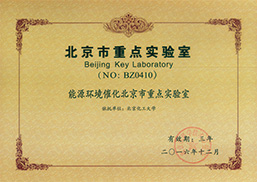重点实验室主任张润铎教授出席“The 9th East Asia Joint Symposium on Environmental Catalysis and Eco-materials”并作特邀报告
会议名称:The 9th East Asia Joint Symposium on Environmental Catalysis and Eco-materials
会议时间:November 5-8th 2019
会议地点:Yancheng,China
报告题目:Strategy on design & preparation of high effective deNOx catalyst

张润铎教授大会风采展示
摘要:
Zeolitic catalysis on air pollution control across microscopic structure, mesocopic behavior, and macroscopic performance
Runduo Zhang*
Beijing University of Chemical Technology,* zhangrd@mail.buct.edu.cn Tel:86-10-64412054
Hao Wang,Shanshan Liu,Ruinian Xu
Abstract:
Nitrogen oxides emitted from mobile sources and stationary sources are one of the main reasons for air pollution. Catalytic technology is the most effective way to solve such environmental problem. Design and preparation of high effective catalysts have become a hotspot on academic research [1-4]. Based on our previous work, we focus on the precise control on topologies of microporous zeolites, the synergistic effect among physicochemical (redox, acidic) properties, and the efficiency of reducing agents on NO removal, so as to achieve high efficiency, high selectivity towards unharmful N2. The main achievements are as follows:
1. Zeolite has a well-developed pore structure, relatively high specific surface area, and plays an important role in the field of low-temperature NO reduction. Among them, SSZ-13 ultramicroporous (~3.8Å) zeolite with CHA topology shows excellent performance in NH3-SCR reaction. While the traditional expensive and highly toxic template of N, N, N-trimethyl-1-adamantyl ammonium hydroxide has limited its practical application. In this case, we first successfully synthesized highly crystallized SSZ-13 using non-toxic and inexpensive choline chloride as a template. At the same time, based on different pore structure (straight channel, straight channel cage hybrid, cage), the SCR performance of a series of topological zeolites was comparatively studied. Combined with experimental results and theoretical calculations, it was found that the cage structure has a stable skeleton and deeper copper ion location, which is beneficial to improve the catalytic performance [5]. In addition, in order to clarify the relationship between crystal morphology and activity, ZSM-5 zeolites with different morphologies (nanosheet, nanoparticle, hollow) were prepared. It was deduced that the nanosheet structure was advantageous for the copper dispersion, exhibited good low-temperature deNOx activity in combination with excellent redox properties, and the hollow structure has a large amount of strongly acidic sites, exhibiting high high-temperature activity.
2. In the study on SCR performances, both acidity and redox have played a key role. The acid property stabilizes the surface adsorbed NH3 to promote high-temperature deNOx activity, and the redox property is favorable for the improvement of low-temperature deNOx activity. In order to clarify the synergistic effect between acidity and redox properties, we have synthesized Ce/Ti, Nb/Ti and NbCe/Ti catalysts and further used for SCR reaction. It was known that more Ce3+ could provide more chemically adsorbed oxygens to enhance redox ability, showing excellent low-temperature NH3-SCR performance. Based on the investigation of surface adsorption species, it was found that the introduction of Nb could increase the acidity of the catalyst, which is beneficial for the high-temperature activity. The results demonstrate a significant synergistic effect existing between Nb (acidic site) and Ce (redox site)[6].
3. The construction and synthesis of core-shell catalysts is one of the popular research fields, and it is expected to improve the hydrothermal stability and ability on poisoning resistance. Therefore, a series of CeTi carriers with diverse structures (Ce/Ti, Ti/Ce, Ti@Ce and Ce@Ti) was prepared, and being used for NH3-SCR reaction after loading with W. It was found that W/Ti@Ce has the best SCR performance. It was proven that W/Ti@Ce had a mesoporous structure, which is beneficial for the well dispersion of W and exhibits good redox ability and acidity, achieving a better deNOx activity. In addition, in the sulfur resistance test, the core-shell catalyst exhibits ideal resistance to sulfur poisoning. The content of Ce3+ on the surface of core-shell catalyst was increased after introducing SO2, indicating the formed sulfate has different influence on Ce and W between supported catalyst and core-shell catalyst [7].
4. Alcohols have attracted much attention as green reducing agents for NO elimination. In particular, CH3CH2OH as a reducing agent exhibits excellent SCR performance on Ag/Al2O3 catalyst. However, CH3OH cannot be used as an effective reducing agent over Ag/Al2O3 for SCR process. Interestingly, it is found that when LaFe0.8Cu0.2O3 perovskite oxide is used as a catalyst, CH3OH can be used as an ideal reducing agent to achieve the satisfactory removal of nitrogen oxides. In this regard, we conducted in-depth research with in-situ DRIFTS and theoretical calculations [8], indicating that using CH3OH as a reducing agent as well as LaFe0.8Cu0.2O3 or Ag/Al2O3 as respective catalyst, the reaction mechanism is essentially different, the carboxylate species are the main intermediate species, and the transfer of H on the C-N bond is the key step of the reaction over the outstanding LaFe0.8Cu0.2O3 perovskite catalyst.
Key words: Nitrogen oxide removal, high N2 selectivity, pore topology, synergy between acidity and redox, core-shell synthesis
References:
[1] R. Zhang, N. Liu, Z. Lei, B. Chen*, Chem. Rev. 2016, 116: 3658-3721.
[2] R. Zhang* et al., J. Catal., 2012, 294: 99-112; 2012, 295: 45-58; 2010, 272: 210-219.
[3] R. Zhang* et al., Environ. Sci. Technol, 2014, 45: 13909-13916; 2012, 46: 11280-11288.
[4] R. Zhang* et al., Appl. Catal. B, 2014, 146: 79-93; 2014, 146: 94-104.
[5] H. Wang, R. Xu, Y. Jin, R. Zhang*,Catal. Today327 (2019) 295-307.
[6] S. Liu, R. Zhang, P. Li, H. Chen, Y. Wei, X. Liang, Catal. Todayhttps://doi.org/10.1016/j.cattod.2019.02.004
[7] S. Liu, H Wang, Y. Wei, R. Zhang*, ACS Appl. Mater. Interfaces 25 (2019) 22240-22254.
[8] H. Wang, R. Zhang*, P Li, S. Royer, J. Dacquin*,J. Catal. 377 (2019) 480-493.



